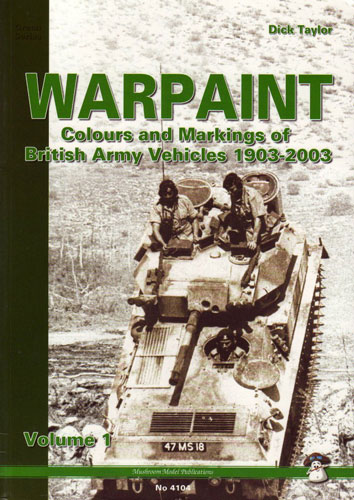|
|
|
|
| Home > Reviews > Britain > WARPAINT – Colours & Markings of British Army Vehicles 1903-2003 Volume 1. Mushroom Model Publications, Green Series. |
WARPAINT – Colours & Markings of British Army Vehicles 1903-2003 Volume 1
Reviewed by Al Bowie
Summary
Title: |
WARPAINT – Colours & markings of British Army Vehicles 1903-2003 Volume 1 by Dick Taylor |
ISBN: |
978-83-89540-63-0 |
Media and Contents: |
Soft Cover A4 portrait style with 104 pages including Colour plates and B&W and colour photos plus extensive tables and a superb Bibliography/ reading list |
Price: |
|
Review Type: |
First Read |
Advantages: |
First to cover this topic to such detail. Excellent reference for the modeller or collector of British Military vehicles post 1903 |
Disadvantages: |
A few captioning issues |
Recommendation: |
Highly Recommended |
FirstRead
For the nation that invented the tank and one having such a military history interspersed with the employment of Armoured and non armoured vehicles, very little is published on British Military Vehicles. With Volume 1 of what will be a four part series Dick Taylor has added to the slowly growing library on the subject.
Dick Taylor not only leans on his skill as an historian but adds to this his career serving on British Armour from the rank of Trooper upward. This intimate knowledge of British Army Vehicles is woven with meticulous and detailed research to provide an excellent reference on British Army Vehicles from their beginnings in 1903 up until 2003. The Acknowledgements list reads like a who’s who of all things British Armour.
Obviously a subject such as this spanning a century will contain a lot of information and the information will be in a four volume series of which this is the first.
The volumes cover the following subjects:
- Volume One
- Chapter 1 - Colours and Sources
- Chapter 2 – Paint and Camouflage up to 1939
- Chapter 3 - Registrations, War Department numbers and Census marks
- Volume Two
- Chapter 1 – Paint and Camouflage in WW2
- Chapter 2 - Sub Unit markings and call sign systems
- Volume Three
- Chapter 1 – Paint and Camouflage post WW2
- Chapter 2 – Arm of Service markings
- Formation Signs
- Volume Four
- Ground and Air Recognition Systems
- Vehicle names
- Miscellaneous marking Systems
This Volume starts with an excellent chapter on Colours and Interpreting sources. This is an excellent chapter and one I hope most pedantic modellers and researchers will read at some stage. It details descriptions of Colours, the British Standard (BS) for Colours, how these may have varied, finish, effects of ageing, application, weathering etc.
He expands this with a section on interpretation of photographic and film sources backed up by an excellent series of photographs to illustrate some of the traps. One particular photograph of an early Churchill alongside a colour shot illustrates how dangerous it can be to guess colours from a B&W picture.
A small section is devoted to Sources and explains to the layman the differences between Primary and secondary sources of research and how that can affect accuracy.
Following on from this is the chapter on Paint and camouflage up to 1939. This section is quite broad and has certainly expanded my knowledge on the subject. It is well supported by research, reference and excellent photographs and colour plates. It not only covers Tanks but also illustrates such diverse things as Artillery, traction engines, wagons and Motor transport.
Dick has detailed the subtle differences in the official camouflage schemes of the time and illustrates some of the more unusual and colourful examples such as the Macleod Ross scheme or the the Jigsaw pattern. These are backed by excellent use of Photographs from a number of different regions that the British Army was garrisoned or served.
The third part of the Book is devoted to Registrations, WD 7 Census Numbers. This is meticulously researched and covers a diverse and complex topic well and presents this in a readable fashion. It is a gain backed by photos and the author discusses some of the pitfalls with commonwealth variations.
This section is rounded out by extensive tables indicating the Range of Numbers allocated to various types, Post 1949 registrations etc.
The book ends with an excellent Bibliography and reading list including periodicals and websites.
I am prejudiced in my enthusiasm for this title as this is my area of interest but I do not believe I am exaggerating to state this is one of the best references on the subject I have read. It is presented logically and in a very readable manner. It is well supported by many photos, plates and tables.
If I had any criticism of the book it would be the captions. A lot of the captions tell you very little about the subject (Unit etc). One example is the Australian Stuart Light tank in the first chapter. The formation badge is clearly visible yet the author makes no attempt to identify the formation (2/6 of the 1st Australian Armoured Div), merely describing it as a Stuart in the Jungle. This is but an isolated example but one I feel would have really added to the title.
I would recommend this book for those with an interest in British military vehicles whether as a modeller, Historian or collector. It is well written, superbly researched and presented in an easy to read manner. I eagerly await the follow on Volumes and one day hope for a hard backed title combining all of these.
Highly recommended to the Collector, Modeller or Historian




